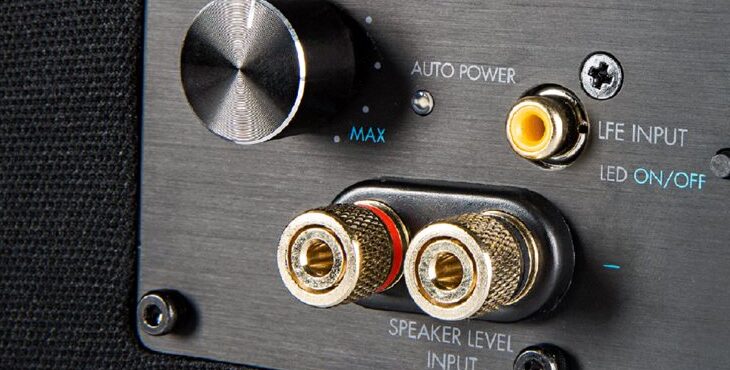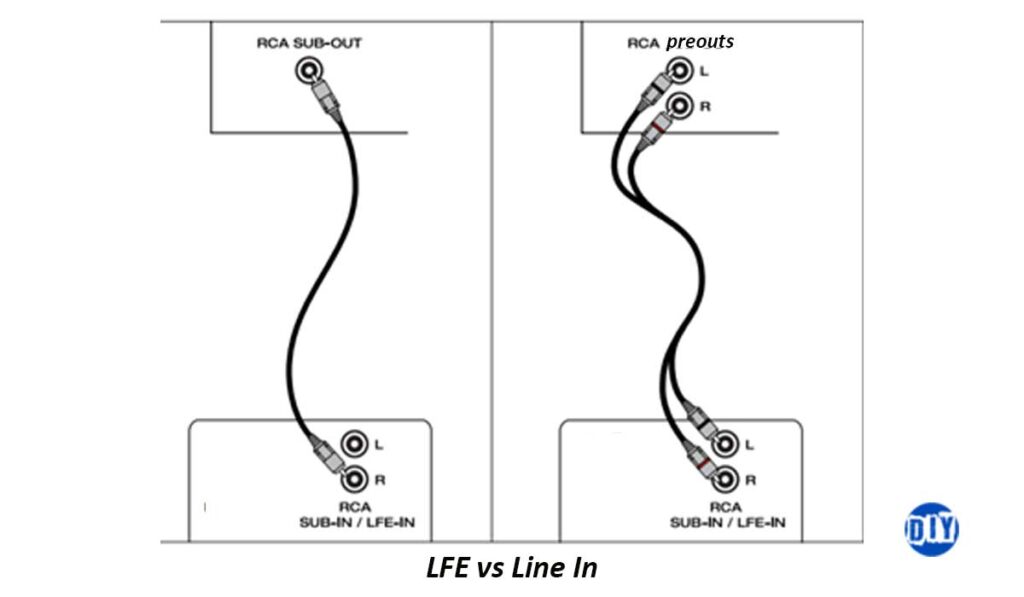When connecting an active subwoofer to a receiver there are one or more inputs you can use;
- LFE input
- Line-in/Line level inputs
- Speaker level inputs
In a nutshell…
The LFE input accepts mono bass signals from an AVR using one RCA cable while the line-in inputs accept 2 RCA connections for left and right stereo signals. Meanwhile, speaker level inputs let you connect a subwoofer to a receiver or amp’s powered speaker outputs using 2 speaker cables.
Both LFE and line-in are line-level inputs that use RCA jacks. The speaker-level inputs are high-level inputs.
An LFE connection is preferred since most bass signals are mono. Line-in inputs connect to an AVR’s left and right pre-outs for 2-channel audio (stereo). Speaker-level inputs are great for a receiver/power amp with no sub outputs.
For further enlightenment, let’s dive deeper into what each input entails.
What is LFE on subwoofer?
The LFE or Low-Frequency Effects channel is a dedicated mono audio path responsible for bass effects such as explosions and gunshots within the 3 to 120 Hz audio frequency range.
On a receiver or other audio processor, the LFE effects are summed/combined with bass from the main left and proper channels into one mono signal which is sent to the sub’s LFE input (mono input) with the use of a mono unbalanced RCA cable.
When using the LFE input, the sub’s internal Low Pass Filter (LPF) is bypassed, thus bass management is done at the receiver (Audio sink). Some subs have a Bypass Switch that does the same.
The sub’s crossover can also be bypassed by setting it higher than the receiver’s. For instance, if your AVR’s crossover point is set at 100 Hz, set the crossover at your sub to maximum, usually around 150 to 180 Hz.
Failing to disable the sub’s low pass filter will cause losses in the sub’s passband and in turn degrade the quality of the bass output.
As such, the low pass filtering is done at your audio sink/receiver. Audio frequencies below the crossover point (passband) are sent to the sub making it easier for the main speakers to playback audio above the cutoff frequency if they are set to “Small”.
Setting your mains to “Large” (LFE+ main) sends full-range signals to the main speakers and low frequencies below the crossover to the subwoofer.
An AVR can have one or more LFE outputs (sub-out). Multiple sub outputs make it possible to send multiple identical mono signals to more than one sub using RCA cables.
For example, receivers with dual LFE outputs (L/R) are intended for use with two subwoofers, L connects to a left sub and R for a right sub.
There is no to combine the two outputs using a Y-cable for a single LFE input. This is because most bass information is mixed as mono as our ears are terrible at picking directional cues at frequencies below 60 Hz or so.
For a sub with 2 RCA inputs (left and right) with none labeled as Mono or LFE, use a Y-splitter cable so the sub receiver has 2 input signals. These are known as line-in inputs.

Subwoofer line-in
The subwoofer’s line-in section uses left and right inputs for transmission of full-range stereo signals (~20 Hz to 20 kHz) from an audio processor such as a receiver.
At the sub’s circuitry, the 2 stereo signals are combined into one since a sub is a mono speaker and most bass information is mixed as mono (one channel). However, combining the left and right bass signals into one subwoofer output can cause phase cancellation lowering the bass output.
Line-in inputs can also accept parallel mono signals (2 mono signals) when a Y-splitter cable/adapter is used from an LFE output. This sums the bass at the output increasing sensitivity by about 6 dB. Thus, you should reduce the sub’s gain at the source by ~6 dB to get the same bass output level as before.
Conversely, this is great for an AVR with one sub-output and a sub with no mono-input.
The connection is completed using 2 RCA cables from the front left and right preouts on your audio processor.
And since full range signals contain low, mid, and high frequencies, the subwoofer’s built-in crossover cuts off the highs, mids, and upper bass at around 80 Hz. The sub only plays back low frequencies below the crossover point.
Some subs have line-level outputs (Line-out) to send audio signals above the cutoff point to an amplifier and speakers or powered speakers with RCA inputs for playback.

Subwoofer speaker level inputs explained
Speakers level inputs are high-level inputs that accept powered signals from a receiver or power amp using speaker cables. This is unlike LFE and line-in inputs which are line-level inputs.
With speaker-level inputs, your main speakers and subwoofer get similar audio signals.
At the subwoofer’s internal circuitry, the high-level signals are stepped down by resistors to line level before amplification by the sub’s internal amplifier.
In this case, the subwoofer receives full-range signals, thus crossover is applied for the sub to only reproduce the lower sound frequencies (bass and sub-bass).
As a side note, a line-level converter can also be used to connect powered outputs from an AVR or amp to a sub without speaker-level inputs. This converter outputs line-level signals (RCA outputs) from a speaker-level feed which is handy for AVRs without dedicated sub outputs.
To Sum up
Assuming you have all the outputs and inputs mentioned above, your specific connection will come down to the available sub outputs and the device you prefer to use for the crossover.
Using a single LFE cable is the most common scenario. The receiver combines all bass information including LFE and bass from the main channels below the crossover point (L+R+LFE) to a mono output.
When line-in or speaker-level inputs are in use, a full-range signal is transmitted. In this case, the sub’s low pass filter dial sets the frequency cut-off point at around 80 Hertz.


